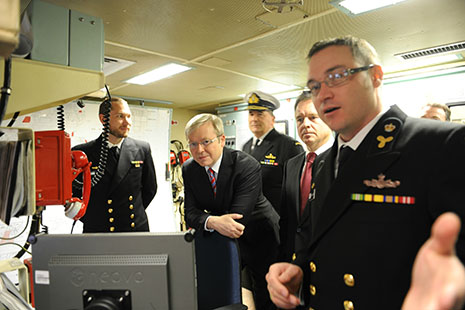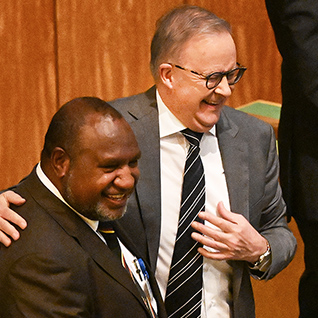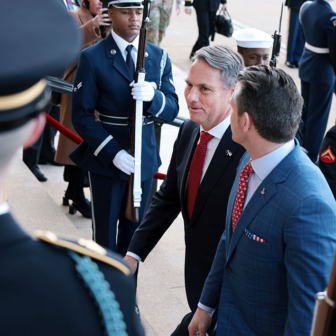AUSTRALIA will be an awesome regional military power if and when it eventually fields the arsenal of new naval, air and land weapons announced in the defence white paper. But it is extremely doubtful that any future federal government will have the money and/or the political will to buy all of the equipment announced by the prime minister.
The white paper says nothing about the cost and time frames for introducing the new submarines, surface ships, aircraft, cruise missiles and army vehicles that are due to be acquired by 2030. But it is safe to say that they will cost many hundreds of billions of dollars to buy and to support through their thirty-year service lives.
While the white paper is clear about the overarching strategic challenge facing Australia – the rise of China as a major economic and military power and the relative decline of the United States – it is notably dodgy about how the government plans to fund its ambitious weapons purchases.
Apparently stung by criticism that the funding plans are confined to the last skimpy one and a half pages of the 138-page white paper, the defence minister, Joel Fitzgibbon, has said that all will be revealed in the government’s budget on 12 May. Not so. The budget will reveal only next year’s spending and forward estimates for the next three or four years.
It will not reveal the full estimated purchase price and through-life support costs of equipment which is to be acquired over, say, fifteen to twenty years. Nor will it detail how and where $20 billion in defence savings will be achieved under a so-called strategic reform plan. Nor will it detail how fully the planned purchases will be funded by the savings plan and by the government commitments to 3 per cent real growth in the defence budget to 2017–18 and to 2.2 per cent real growth from 2018–19 to 2030.
So it is hardly surprising that some defence experts see the acquisition plan as a work of fiction, a political gesture designed to show that the government is tough on defence even under the pressures of the global financial crisis (which hardly rates a mention in the white paper). Despite the real strategic challenges facing Australia, it seems a fair bet that the acquisition plans will be modified, cut back and/or delayed in future years when governments face the reality of having to stump up the money for what represents an unprecedented peacetime rearmament program.
Consider the cost implications of just three of the planned purchases: the twelve new submarines, 100 F-35 joint strike fighters and three air warfare destroyers. Their currently estimated purchase prices (respectively $25 billion, $16 billion and $6 billion) bear little resemblance to their through-life cost. Assuming conservatively (very conservatively) that the through-life cost is three times the purchase price, the cost of the submarines will amount to $100 billion, the joint strike fighters $64 billion and the air-warfare destroyers $24 billion. Total cost: $188 billion over their service lives.
But in addition to these capabilities the white paper has announced the acquisition of eight new frigates, two large amphibious landing ships, twenty-four naval combat helicopters, eight new maritime patrol aircraft, six new landing craft, two more Hercules aircraft, ten light tactical fixed-wing aircraft, and seven new helicopters and 1100 protected land vehicles for the expanded army. Then there is the planned acquisition of cruise missiles, a satellite and anti-cyber warfare capabilities.
Given the accepted three-to-one capital cost/through-life support formula, it is easy to find another $100 billion plus in these acquisitions. If a more generous ratio is assumed (and some defence experts say ten-to-one is closer to reality) then the government’s acquisition plan assumes stratospheric dimensions out to 2030. Guaranteed real annual budget increases, and extremely doubtful savings of $20 billion, would go nowhere near meeting the costs.
Some cutbacks would hardly matter. It would be absurd for Australia to aspire to match China alone. It has to find its security in alliance with others, especially the United States, which will remain the preeminent global power past 2030 and fully capable of coping with Beijing’s rise.
And despite the view of Ross Babbage, Kevin Rudd’s military adviser du jour, it would be absurd for Australia to aspire to “rip the arm off” a major Asian power. Defence expert Allan Behm has already labelled this the “Auntie Jack” theory of strategic security.
All of which brings us back to that defence department giant, the late Sir Arthur Tange. Tange famously said “You are not talking strategy until you are talking dollars.” Tange’s epigram should be tattooed on the foreheads of Kevin Rudd and Joel Fitzgibbon. At present the suspicion has to be that they are talking more about politics that about real strategic choices. •




